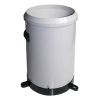Used HyQuest Solutions TB6 Tipping Bucket Rain Gauge
Features
- Long term stable calibration
- Minimal maintenance required
- Robust design for all environments
- Expedited repair and warranty service
- Lifetime technical support
- More
HyQuest Solutions’ TB6 Series II is a high-quality tipping bucket rain gauge for measuring rainfall in urban and rural locations. The TB6 is the device of choice for accurately measuring low rainfall events and still provides good accuracy measuring heavier rain events. The tried and proven design of the TB6 Series II ensures long-term, accurate and repeatable results. It is manufactured from high quality, durable materials ensuring long-term stability in the harshest of environments. It consists of a robust powder-coated aluminium enclosure, a UV-resistant ASA polymer base, and stainless steel fasteners and finger filter. TB6 Series II provides a finger filter that ensures the collector catch area remains unblocked when leaves, bird droppings and other debris find their way into the catch. The base incorporates two water outlets at the bottom allowing for water collection and data verification.
Maintenance of the TB6 Series II is easy, because removal of the outer enclosure and access to the tipping bucket mechanism and finger filter assembly is made easy with quick release fasteners. The new more spacious enclosure makes maintenance even easier. TB6 Series II includes a dual output 24 V DC reed switch allowing for output redundancy or the addition of a second data logger. The second output could also be used for connecting HyQuest Solutions’ Bluetooth pulse counter CMCbt paired with the free FCD application that allow for easy and accurate field calibration even in noisy (urban) environments. The reed switch incorporates varistor protection against surges that may be induced on long, inappropriately shielded signal cables.
In The News
Expanding the Port Everglades: Real-Time Monitoring of Water Quality Conditions from Planned Dredging Operation
The Port Everglades in Broward County, Florida, serves large trade vessels and cruiseliners and incoming and outgoing recreational boaters. However, as cargo ships become larger, the port must expand. A dredging project led by the US Army Corps of Engineers will substantially deepen and widen the port's navigation channel to accommodate larger Panamax cargo ships and modern cruise liners. As a result of this project, a large amount of sediment will be displaced into the water column. This suspended sediment may settle outside of the project area, burying benthic organisms like corals, and possibly carrying harmful particulates to other regions. [caption id="attachment_39497" align="aligncenter" width="2560"] A CB-950 and CB-25 deployed on site at Port Everglades.
Read MoreIt’s Time to React to Water Quality: Proteus Multiparameter Probe aboard NexSens Buoy
Water quality monitoring is essential for safeguarding public health, protecting ecosystems, and ensuring the sustainability of water resources. Contaminants such as industrial pollutants, agricultural runoff, and sewage discharge can severely impact aquatic life and pose serious risks to human health if left unchecked. Traditionally, water quality monitoring has been a slow and labor-intensive process, requiring samples to be collected, transported to a lab, and analyzed—a process that can take days. However, with the advancement of real-time sensor technology, environmental agencies, researchers, and industries can now monitor water quality instantly.
Read MoreSafeguarding Communities with Real-Time Flood Monitoring in the City of Hazelwood
The City of Hazelwood is a suburb in St. Louis County, Missouri, home to around 25,500 people. Recently, the community has suffered increased flash flooding following severe storms, prompting the need for the installation of a flood monitoring system. In 2022, a NexSens X2 data logger was installed to monitor water level and rainfall in real-time, with the aim of reducing the loss of life and property as a result of extreme weather events. [caption id="attachment_39411" align="alignnone" width="940"] The latest flood event at Coldwater Creek, where the water level rose by 14 feet, exceeding the height of the X2 by three feet. The sensor can be seen behind the wall that usually contains the Creek.
Read More














